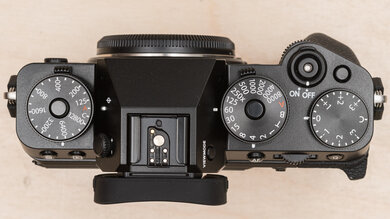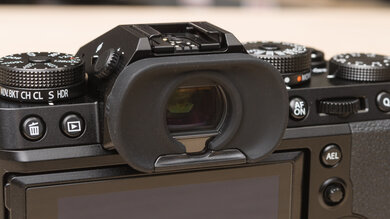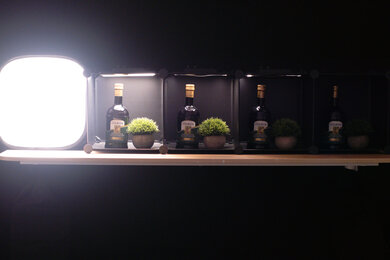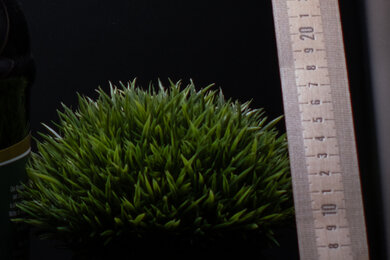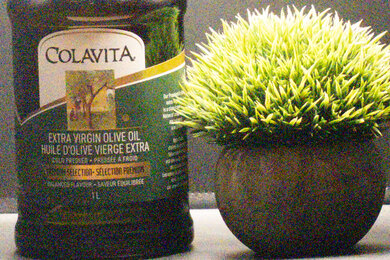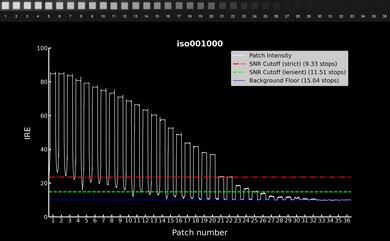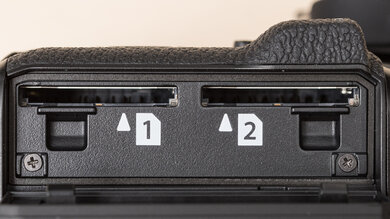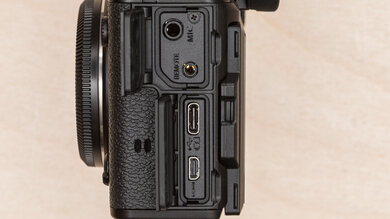The Fujifilm X-T5 is a mirrorless APS-C camera. In a lot of ways, it represents a return to the photography-oriented roots of the X-T series—whereas the Fujifilm X-T4 was the most video-oriented camera in the series thus far, the X-T5 brings back the three-way tilting screen of the Fujifilm X-T3, has a lighter and more portable body, and shares its new 40.2MP X-Trans CMOS 5 HR sensor (the 'HR' stands for high resolution) with the flagship Fujifilm X-H2. This is the camera for those looking for the traditional Fujifilm shooting experience, with dedicated exposure dials and a marked focus on photography in an increasingly video-centric market.
Our Verdict
The Fujifilm X-T5 is great for travel photography. It's relatively portable, has a high-res EVF, and a tilting screen that's great for waist-level shots. Its high-resolution sensor captures stunningly detailed images, with plenty of leeway to crop your photos, and its in-body image stabilization can help you shoot at slower shutter speeds handheld. Battery life is also excellent for a mirrorless camera. It isn't the most comfortable camera to shoot with because of its small hand grip.
- Relatively portable design.
- Dedicated exposure dials make it easy to adjust settings.
- Excellent battery life.
- Excellent autofocus system.
- Ergonomics are just decent.
The Fujifilm X-T5 is great for landscape photography. Its high-resolution sensor is great for landscapes and prints, giving you more leeway to crop your photos. It also has an impressive amount of dynamic range for an APS-C sensor, which is great for high-contrast landscapes. The camera is also relatively portable and well-built, with some weather sealing for peace of mind on long hikes in adverse weather conditions. It has an excellent battery life too. However, it isn't the most comfortable to hold because of its small handgrip.
- Relatively portable design.
- Dedicated exposure dials make it easy to adjust settings.
- Excellent battery life.
- Excellent dynamic range.
- Ergonomics are just decent.
Though the Fujifilm X-T5 is great for sports and wildlife photography, it has some limitations. The biggest one is the size of its photo buffer. Because the camera captures such large image files, its buffer fills up quickly, slowing you down at a critical moment. It can shoot at a very quick max burst rate and has an excellent autofocus system with a reliable tracking feature and several different subject detection modes, including ones specifically for animals, birds, and different types of vehicles.
- Relatively portable design.
- Dedicated exposure dials make it easy to adjust settings.
- Excellent battery life.
- Quick burst shooting.
- Excellent autofocus system.
- Ergonomics are just decent.
- Large files fill up buffer very quickly.
The Fujifilm X-T5 is decent for vlogging, but this isn't its main intended use. Unfortunately, it doesn't have a fully articulated screen that you can flip all the way around to face you for selfie vlogs. However, it is a very capable video camera, with recording in up to 6.2k resolution, plenty of frame rate options, and advanced features like Log recording and RAW video output via HDMI. It also has a great autofocus system with a reliable face-tracking feature that ensures you stay in focus while recording.
- Relatively portable design.
- Excellent battery life.
- Great video quality and autofocus.
- Ergonomics are just decent.
- No fully articulating screen.
- Not the most portable for on-the-go vlogging.
Despite being more photography-oriented, the Fujifilm X-T5 is excellent for studio video. It supports 10-bit 4:2:2 recording internally, with Log profiles to capture a wider dynamic and tonal range, along with RAW 6.2k video output over HDMI with a compatible external recorder. It can record 6.2k video and oversampled 4k at up to 30 fps, regular 4k at up to 60 fps, and 1080p at up to 240 fps in its slow-motion recording mode. The video quality is great too. While it has an excellent battery life and good heat management, you can extend it with an external power supply via USB-C if needed, which is great for longer recording sessions.
- Relatively portable design.
- Excellent battery life.
- Internal 10-bit 4:2:2 recording in Log.
- RAW 6.2k video output to compatible external recorder via HDMI.
- Ergonomics are just decent.
POV-style action video isn't the Fujifilm X-T5's strength, but it gets the job done if you want to film action from the sidelines. Though it can record regular 4k and 1080p video at up to 60 fps—with a slow-motion recording mode that captures 1080p footage at up to 240 fps—it can only capture the highest-quality 6.2k and oversampled 4k video at up to 30 fps. It's a well-built camera but can't withstand extreme weather conditions or mount-to-action video rigs. On the upside, video quality is great, and it has a relatively long battery life.
- Relatively portable design.
- Excellent battery life.
- Super slow-motion recording in 1080p.
- Ergonomics are just decent.
- Not rugged or waterproof.
- Limited frame rate options at high-resolution settings.
The Fujifilm X-T5 has great RAW image quality. Its exceptionally high-resolution sensor captures an impressive level of fine detail and gives you more room to crop in your photos. It also has amazing dynamic range, allowing you to capture high-contrast scenes with a wide range of highlight and shadow detail. That said, its noise handling is just decent in low light.
- Excellent dynamic range.
- Very high resolution sensor.
- Decent noise handling.
Performance Usages
Changelog
-
Updated Feb 12, 2025:
We wrote text for the new tests added in Test Bench 0.13.
- Updated Feb 03, 2025: We've converted this review to Test Bench 0.13. We've added new tests for Video Dynamic Range and Luminosity Patch Detection. You can learn more about these updates in the changelog.
- Updated Aug 20, 2024: We added a comparison to the Fujifilm X-T50 in the Portability section.
- Updated Jul 25, 2024: We've added comparisons to the Fujifilm X100VI in the Portability and Sensor sections of this review.
Check Price
Differences Between Sizes And Variants
The Fujifilm X-T5 comes in 'Silver' and 'Black.' We purchased the black model; you can see our unit's label.
You can buy the camera body on its own or bundled with a kit lens like the XF 18-55mm f/2.8-4 R LM OIS or the XF 16-80mm f/4 R OIS WR, depending on the retailer.
Let us know if you come across a different variant, and we'll update our review.
Popular Camera Comparisons
The Fujifilm X-T5 has one of the highest-resolution sensors of any APS-C camera on the market today, and with a relatively compact body, this is a camera designed for photographers who don't want to sacrifice portability for image quality. Like its predecessor, it features a highly effective in-body image stabilization (IBIS) system and high-res EVF but brings back the 3-way tilting screen from older X-T series cameras. And with an updated autofocus system and even better video specs for the hybrid shooters among us, this is the most formidable X-T camera yet.
For other options, check out the best cameras for photography, the best mirrorless cameras, and the best cameras for travel.
The Fujifilm X-T50 is like a mini version of the Fujifilm X-T5. Each camera uses the same high-resolution APS-C sensor, so image quality is comparable, but they offer different shooting experiences and ergonomics. If you're looking for a more portable camera for travel or street photography, the X-T50 has an advantage. However, the X-T5 is more robust, with more control dials, a higher-resolution viewfinder, a bigger battery, and dual SD card slots.
The Nikon Z f and the Fujifilm X-T5 are both great cameras with vintage-inspired designs. However, they use different-sized sensors. The Fujifilm uses a higher-resolution APS-C sensor. It's more portable and features a tilting screen that some may prefer. Overall, it has slightly better ergonomics and a longer battery life. On the other hand, the Nikon has a fully articulated screen, which some may prefer over the tilting screen on the X-T5, and its PSAM control scheme, with additional dials for ISO and shutter speed, may be more familiar to some shooters. Ultimately, the Fujifilm is better if you prefer an APS-C sensor and lenses, but if you prefer full-frame, the Nikon is better.
The Fujifilm X-T5 is better overall than the Fujifilm X-M5. It's more robust, with better ergonomics and slightly more advanced video features. It also has a viewfinder, which makes it a better fit for photography. However, the X-M5 is significantly more compact.
The Sony α6700 and the Fujifilm X-T5 are both excellent APS-C cameras. The Fujifilm is more of a photography-first camera, with a higher-resolution sensor, dedicated exposure dials, a larger viewfinder, and a tilting screen. The Sony is a better hybrid option, with a fully articulated screen and more frame rate options.
Test Results

The Fujifilm X-T5 is fairly portable for an interchangeable lens camera. It's marginally smaller and lighter than the Fujifilm X-T4, bringing the camera closer in dimension to older models in the X-T series while still managing to implement an IBIS system. Not that the X-T4 is a behemoth, but it's nice to see Fujifilm keeping the size down since the portability of the X-T series is one of its strengths compared to full-frame camera systems. If you're looking for even more portability, the Fujifilm X100VI features the same sensor in an even more compact form factor. However, if you still want the flexibility of interchangeable lenses, the Fujifilm X-T50 is like a mini X-T5.
The camera's build quality is excellent. The frame is hard plastic, with a magnesium alloy top plate, all of which feel robust. The screen mechanism feels secure, and while some of the buttons and dials have a bit of wobble, they also feel solid overall. Fujifilm also says there are 56 weather-sealed points for dust- and moisture resistance and that the camera can operate in temperatures as low as 14°F (-10°C).
The Fujifilm X-T5 continues the X-T series tradition of having dedicated ISO, shutter speed, and exposure compensation dials right on the top plate, making it easy to adjust exposure settings. However, unlike previous models in the series, the X-T5 no longer has a battery grip attachment point.
While the max mechanical shutter speed is 1/8000s, the camera can also shoot at an incredibly quick 1/180,000s shutter speed in electronic shutter mode. While most situations will never require shutter speeds that quick, it's a good option when shooting in very bright sunny conditions with a wide-open aperture.
The Fujifilm X-T5 is decently comfortable to shoot with. It doesn't have the largest handgrip, so it can feel a bit cramped, especially if you have larger hands. Still, the grip feels nice and a bit more secure than the texture on the Fujifilm X-T4. The rubber eyecup also feels quite comfortable. On top of that, it's very easy to adjust exposure settings with the dedicated dials on the top plate. You can lock the dials to stop you from accidentally changing settings. Like the X-T4, the shoulder strap attachment points can get in the way of your index finger, and the shutter button is a tad on the mushier side.
The EVF has a 3.69 million dot resolution, which is great and gives you a crisp view. That said, while it's sharper than typical on cameras at this price point, it isn't as high-res as the viewfinder on the flagship Fujifilm X-H2.
The Fujifilm X-T5 brings back the 3-way tilting screen from the Fujifilm X-T3 and previous models. It can tilt up and out like a standard tilt screen, but it also tilts out horizontally and down. It has a higher resolution than the screen on the Fujifilm X-T4, ensuring a crisp image when shooting with the display. It also gets very bright, enough to overcome glare on sunny days. However, touch functionality is limited to selecting focus points, taking photos, and adjusting settings while recording video.
The menu system is quite good overall but isn't the most intuitive interface. For example, the human face/eye detection setting is separate from the other subject detection modes. Some of Fujifilm's terminology also differs from other brands, like metering settings being labeled 'Photometry'. It's easy to navigate, but it can sometimes be sluggish or unresponsive. Thankfully, there are plenty of customization options, including 'My Menu' pages to access your most frequently used settings and the quick menu you can pull up while shooting.
In addition, you can download Fujifilm's XApp (screenshot of the app interface here), which lets you control the camera remotely, backup your settings, and transfer files from your camera directly to your smartphone (excluding RAW files). Using the app for Live View works okay but can be very laggy.
Like the Fujifilm X-H2 and Fujifilm X100VI, the Fujifilm X-T5 uses a high-resolution backside-illuminated sensor that Fujifilm claims has an improved pixel structure for better light-gathering ability. With this new sensor, the base native ISO is now 125, as opposed to ISO 160, which was the native base on previous X-series cameras, including the Fujifilm X-T4. The new X-Processor 5 advertises twice the processing speed as the previous generation. If you're looking for a vintage-inspired camera with a full-frame sensor, check out the Nikon Z f.
The camera's battery life is fantastic. It has a 580-shot CIPA rating, an improvement over the Fujifilm X-T4, and excellent for a mirrorless camera. In the power-saving Economy mode, that bumps up to 740 shots on a full charge. Of course, you should take CIPA ratings with a grain of salt since real-world performance can vary depending on settings and how you use your camera. Still, it's a good indicator of how a camera might perform relative to other models. If you're looking for a Fuji camera with even better battery life, check out the Fujifilm X-S20.
In video mode, the camera can record for about two hours of continuous video recording in oversampled 4k 'HQ' resolution or 6.2k. We didn't manage to capture the advertised 130 minutes, but we came very close, which is excellent. If you need to extend the camera's battery life, you can also connect it to an external power source or power bank via USB-C.
The Fujifilm X-T5 has a very quick max mechanical burst rate, making it a great fit for capturing faster subjects in burst mode. If you switch to the electronic shutter, it can shoot at an even faster max burst rate of 20 fps, 13 fps, or 10 fps. However, when you enable the electronic shutter, the image crops in about 1.29x, as you can see here. If you want to avoid the crop, you'll have to stick with the mechanical shutter. While the camera can shoot very quickly, the high-resolution images fill up the buffer just as quickly. With a high-speed SD card, you can capture around 20 RAW frames before the buffer fills up and the camera starts to slow down. It's a bit better with JPEG files, but it still fills up quickly relative to other cameras. Unlike the Fujifilm X-H2, which uses the same high-resolution sensor, the X-T5 doesn't support CFexpress cards, which allow the X-H2 to clear its buffer much faster, thus giving it an effectively larger buffer capacity before it starts to slow down.
The Fujifilm X-T5 uses the same AF system as its flagship sibling, the Fujifilm X-H2S, with what Fuji says is an updated algorithm that improves its predictive capabilities. It's a notable step up from the Fujifilm X-T4, with much more reliable tracking when shooting continuously. Even with faster or more erratic subjects, it's very accurate and nails focus most of the time. The camera has your typical face and eye tracking, as well as expanded subject detection modes that include Animal, Bird, Automobile, Motorcycle, Airplane, and Train categories. However, the interface isn't the most intuitive, with the subject detection modes separate from the human face/eye detection, meaning an extra step if you want to quickly switch from tracking a human subject to a vehicle or bird, for example.
Without tracking and using a single center focus point, the autofocus is very effective. It has no trouble staying with moving subjects behind the focus point. We tested AF using the Fujinon XF 16-55mm f/2.8 R LM WR lens, which has a quick linear focusing motor.
The Fujifilm X-T5 has an in-body image stabilization system that Fujifilm advertises to have up to seven stops of stabilization. We tested stabilization using the Fujifilm XF 16-55mm f/2.8 R LM WR lens, which doesn't have optical stabilization, and the camera still did a great job of stabilizing shots taken at very slow shutter speeds. That said, stabilization performance can vary depending on many factors, including not just the lens but what focal length you shoot at and how steady your hands are.
The Fujifilm X-T5 has excellent dynamic range. It captures a wide array of shadow and highlight detail, which is great for high-contrast scenes like landscapes.
Thanks to the high-resolution sensor, the Fujifilm X-T5 captures an impressive amount of fine detail. Images look very crisp, even when you punch in, and there's plenty of room to crop your photos.
Like the Fujifilm X-H2, the X-T5 includes a 'Pixel Shift Multi Shot' feature. The Pixel Shift mode takes a series of 20 RAW photos, using the camera's in-body image stabilization system to move the sensor in tiny increments for each frame. Then, using the Fujifilm 'Pixel Shift Combiner' software, you can combine the images into an ultra-high-resolution composite photo of up to 160 megapixels. Here's a sample Pixel Shift photo taken of our test scene. It's a great feature to have for very high-quality product photos, for example, since you should only use this mode for static subjects and scenes, and it's best used with a tripod. If there's even slight movement with the camera or in the scene, you'll get pixelation and artifacts, which you'll notice if you zoom in on our outdoor sample photo here.
The camera's noise management is decent but performs well for such a high-resolution APS-C sensor. The camera retains a fair amount of detail in low light. Though noise is inevitable with less available light, it won't be overly noticeable except in very dark environments where you have to bump the ISO.
Though the Fujifilm X-T5 is geared more towards photography, it's also a very capable video camera, with video recording in 6.2k resolution at up to 30 fps, oversampled '4k HQ' at up to 30 fps, and sub-sampled 4k at up to 60 fps. Both of the 4k modes include the option to record regular UHD 4k or DCI 4k with a slightly wider, more cinematic 17:9 aspect ratio. The camera also supports RAW 12-bit video output in 6.2k at up to 30 fps with a compatible Atomos or Blackmagic recorder via HDMI.
Unlike the Fujifilm X-H2 or Fujifilm X-H2S, the Fujifilm X-T5 doesn't support ProRes codecs internally since they require a CFexpress card.
The Fujifilm X-T5 has a wide selection of frame rates in 4k. In the normal 4k mode, it can capture 4k video at up to 60 fps, although shooting in 4k / 60 fps incurs a bit of a crop. In the oversampled 4k HQ mode, it's limited to a max of 30 fps.
The camera has fantastic 4k internal recording capability. Like the more video-oriented Fujifilm X-H2S and Fujifilm X-H2, it supports both F-Log and F-Log 2 to take full advantage of the sensor and capture a wider dynamic range. With internal 10-bit 4:2:2 recording, you'll also have more flexibility when color-grading your footage. It's a step up from the Fujifilm X-T4 in that respect, as the X-T4 was limited to 10-bit with 4:2:0 subsampling. Another improvement over its predecessor is the elimination of recording time limits, which is great for long-form content or streaming. The camera also has excellent heat management and is a bit more efficient than the X-H2 and X-H2S when it comes to overheating, as we didn't experience any overheating interruptions, even in the 4k HQ mode. Unlike those models, there's no compatible cooling fan accessory, and the camera doesn't have mounts to attach one because of its tilting screen. That isn't surprising, though, since the X-T5 is more photography-oriented, while the X-H models aim at hybrid/advanced video shooters.
The autofocus is incredibly effective in video mode, although it performs notably better in 6.2k and 4k HQ resolution than in the regular 4k mode. The above results are for the 4k HQ mode, but you can see how the autofocus performs in regular 4k mode here for object tracking and here for face tracking. 6.2k object tracking is included here for reference. Generally, though, the autofocus is quite reliable and tracks moving subjects quickly and accurately.
In addition to human face/eye detection, you can choose between different subject detection modes, including Animal, Bird, Automobile, Motorcycle, Airplane, or Train. With continuous autofocus, you can choose between two area modes: 'Multi', which automatically detects and tracks a subject in the frame, and 'Area', which gives you a smaller moveable focus area. However, unlike competitors like Canon or Sony, there's no general selectable subject tracking outside the camera's automatic subject detection modes.
The camera captures amazing video quality in 4k. Thanks to the higher-resolution sensor, it's even better than its predecessor, capturing a slightly crisper image overall. The results above pertain to the oversampled 4k HQ resolution. You can see a test scene extract from the regular 4k resolution here and 6.2k resolution here. You can also see a low light sample in 6.2k here.
Unfortunately, there's noticeable rolling shutter effect in 4k HQ. It's about the same as in 6.2k, which you can see here. You'll see some skewing or wobble with quick camera pans, but it isn't horrible overall. In regular 4k resolution, it's a bit less pronounced, with a rolling shutter degree of 4.7°. You can see the video for regular 4k here.
The Fujifilm X-T5 can record regular full-speed 1080p video at up to 60 fps without a crop. Like other Fujifilm cameras, it has a high-speed recording mode that can record slow-motion footage at up to 240 fps, with playback options for 2x, 4x, or 8x slow motion. This mode doesn't record any sound and imposes a significant crop. Thankfully, the autofocus tracking still works in high-speed recording mode, which is great. You can see an example of slow-motion footage in 1080p at 240fps here. Even at 240 fps, the quality is quite good in bright conditions, though it degrades somewhat in low light.
In 1080p, the camera's internal recording capability is still great, though we couldn't achieve the advertised max bit rate of 360 Mbps. As with 4k, it can record 10-bit 4:2:2 video internally, and there's no recording time limit.
The autofocus is notably worse in 1080p than in the oversampled 4k HQ mode, but it's still very good overall. It does an excellent job of tracking moving human subjects and works best when letting the camera detect a subject rather than trying to select a target manually. In those cases where you want to track an object that doesn't fall into a subject detection mode, it can be sluggish to keep up with whatever is behind the focus area.
The rolling shutter effect is less noticeable in 1080p. There's still some skewing with very fast camera movements, but it isn't too bad overall.
The camera's video dynamic range is fantastic. It captures a very wide dynamic range above the background floor, so there's more latitude to recover shadow details in post, but its usable dynamic range is closer to about 9 to around 11 stops, depending on your tolerance for noise. Overall, it can record a wide ratio of highlight to shadow detail, giving you more flexibility to shoot in trickier lighting conditions.
Tested Settings:
- Resolution: 4k
- Frame Rate: 30 fps
- Log Format: F-Log2
The Fujifilm X-T5 has great latitude in the shadows, with a large number of its dynamic range stops detectable below middle gray. It does a good job of preserving highlight detail as you raise the ISO as well.
Tested Settings:
- Resolution: 4k
- Frame Rate: 30 fps
- Log Format: F-Log2
The Fujifilm X-T5 includes a USB-C port for charging, file transfer, and power delivery. There's also a Micro HDMI port, so you'll likely need to use an adapter if using an external recorder or display, unlike the Fujifilm X-H2 or Fujifilm X-H2S, which are more video-centric and have full-sized HDMI ports. It also has a mic input to connect an external microphone. Like the Fujifilm X-T4, there's no headphone jack, but you can use headphones with a USB-C-to-headphone adapter, which comes in the box.



